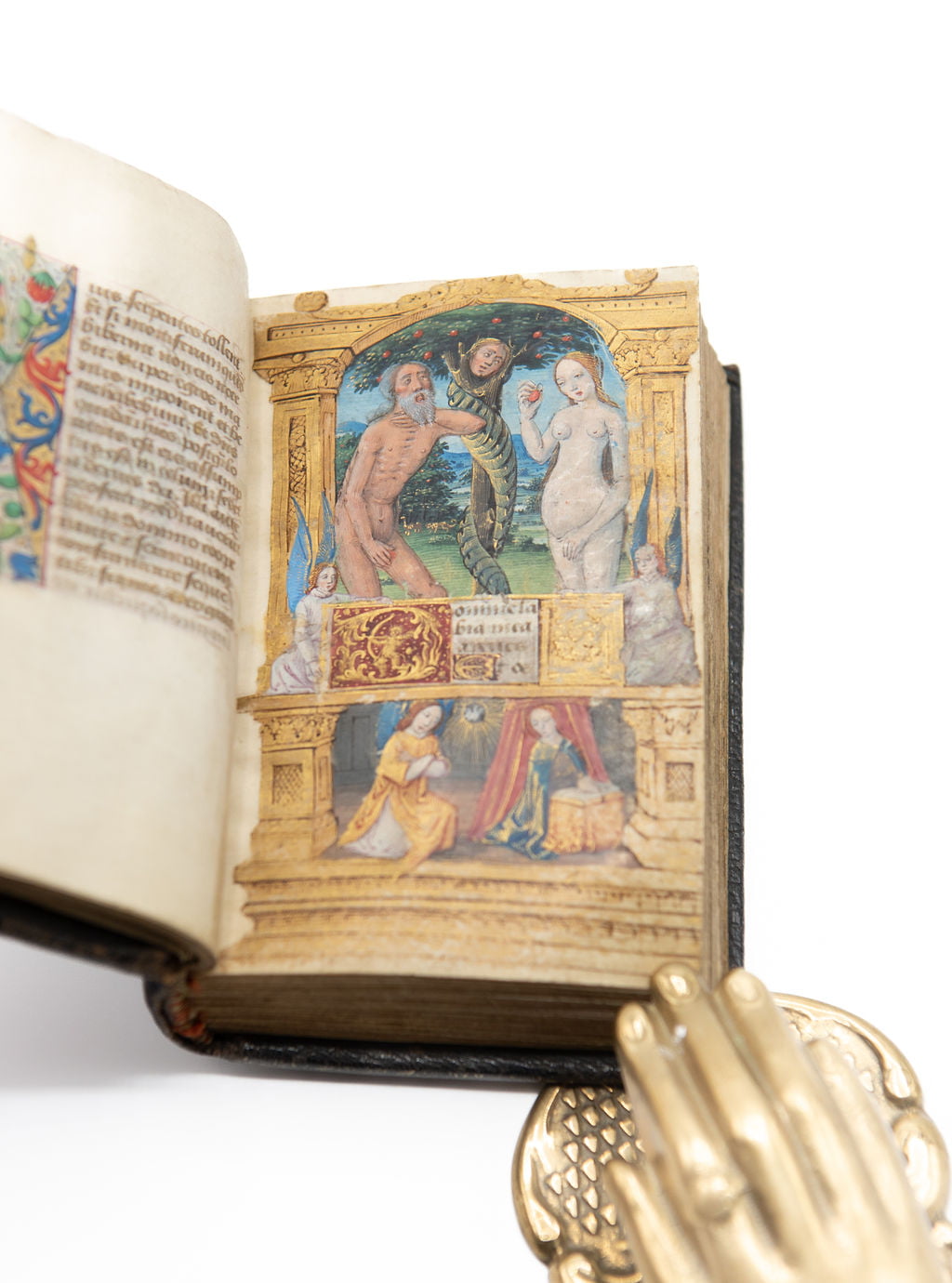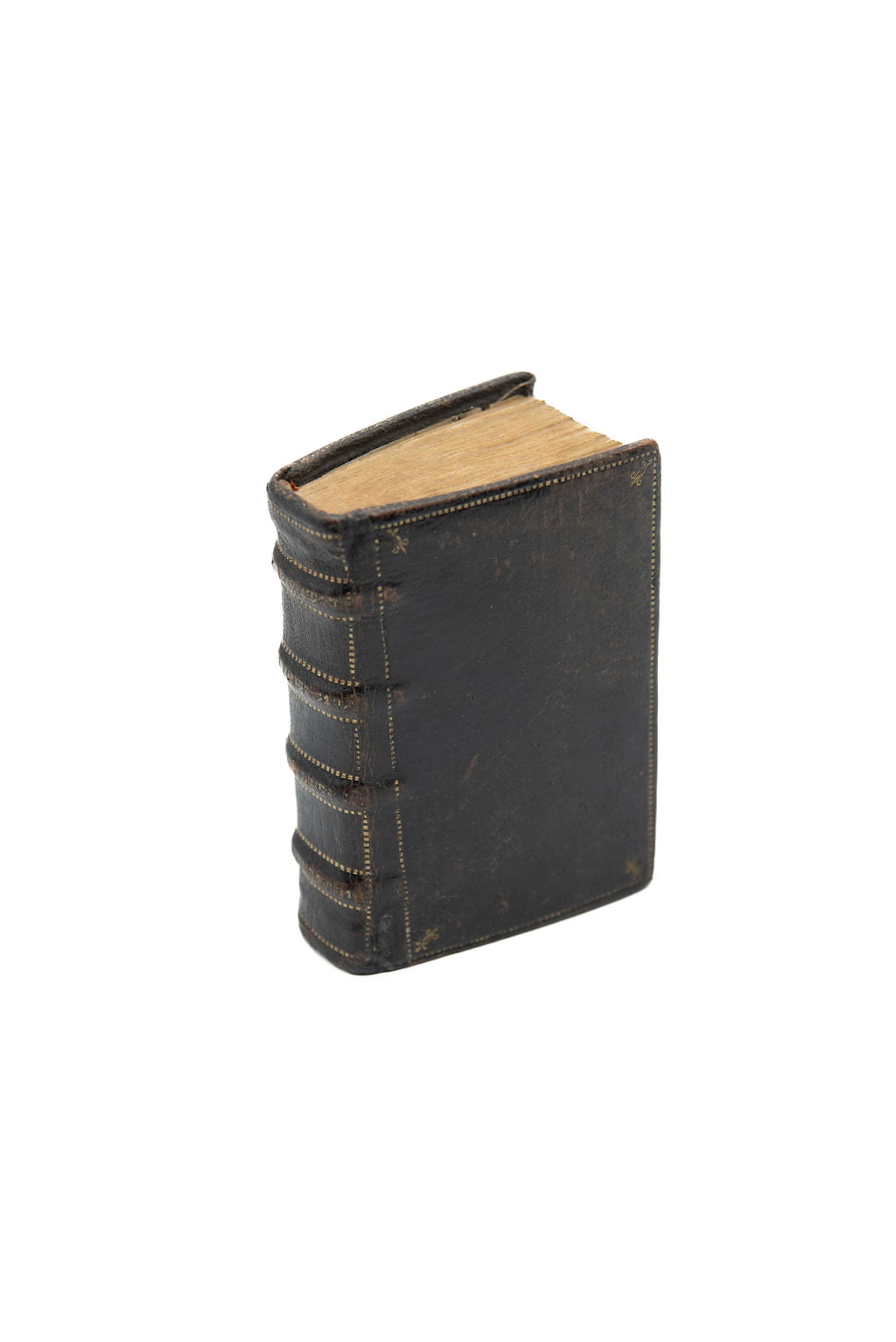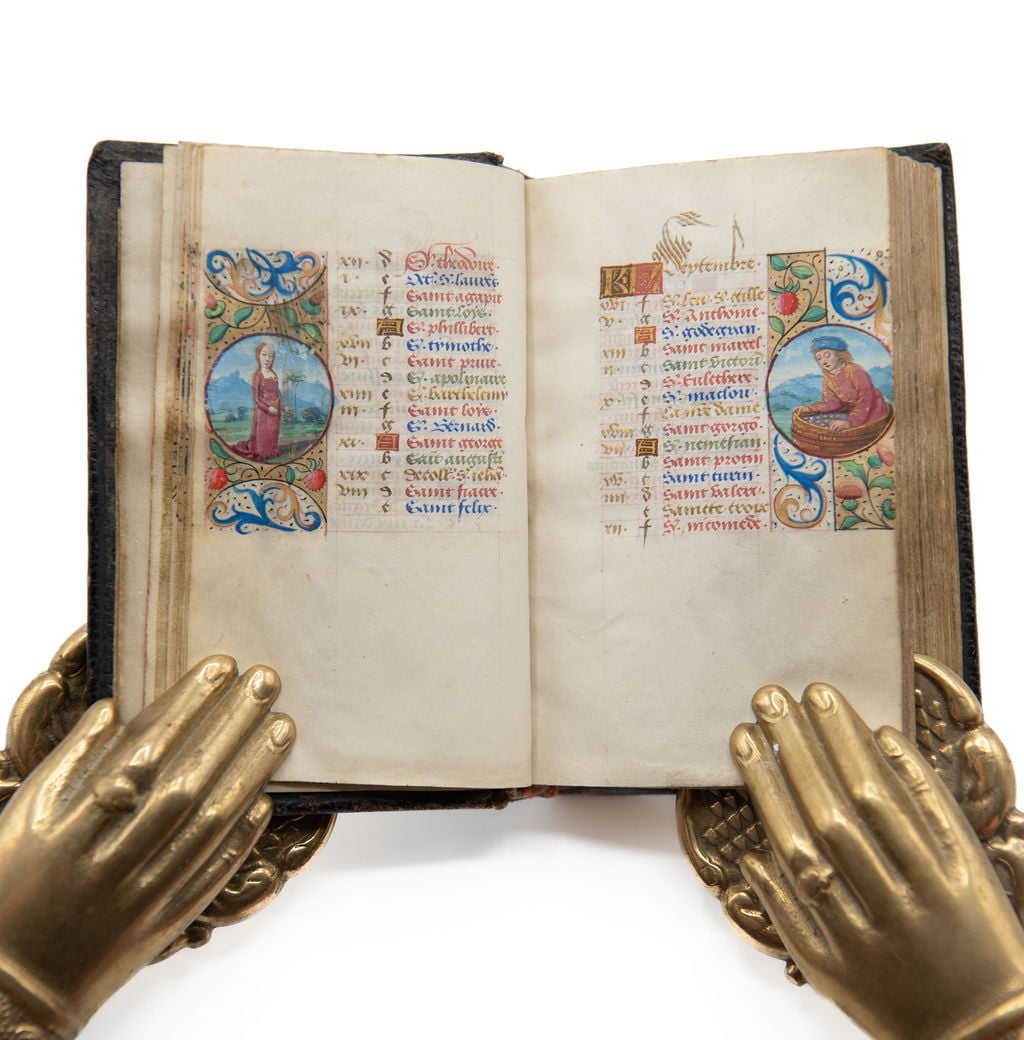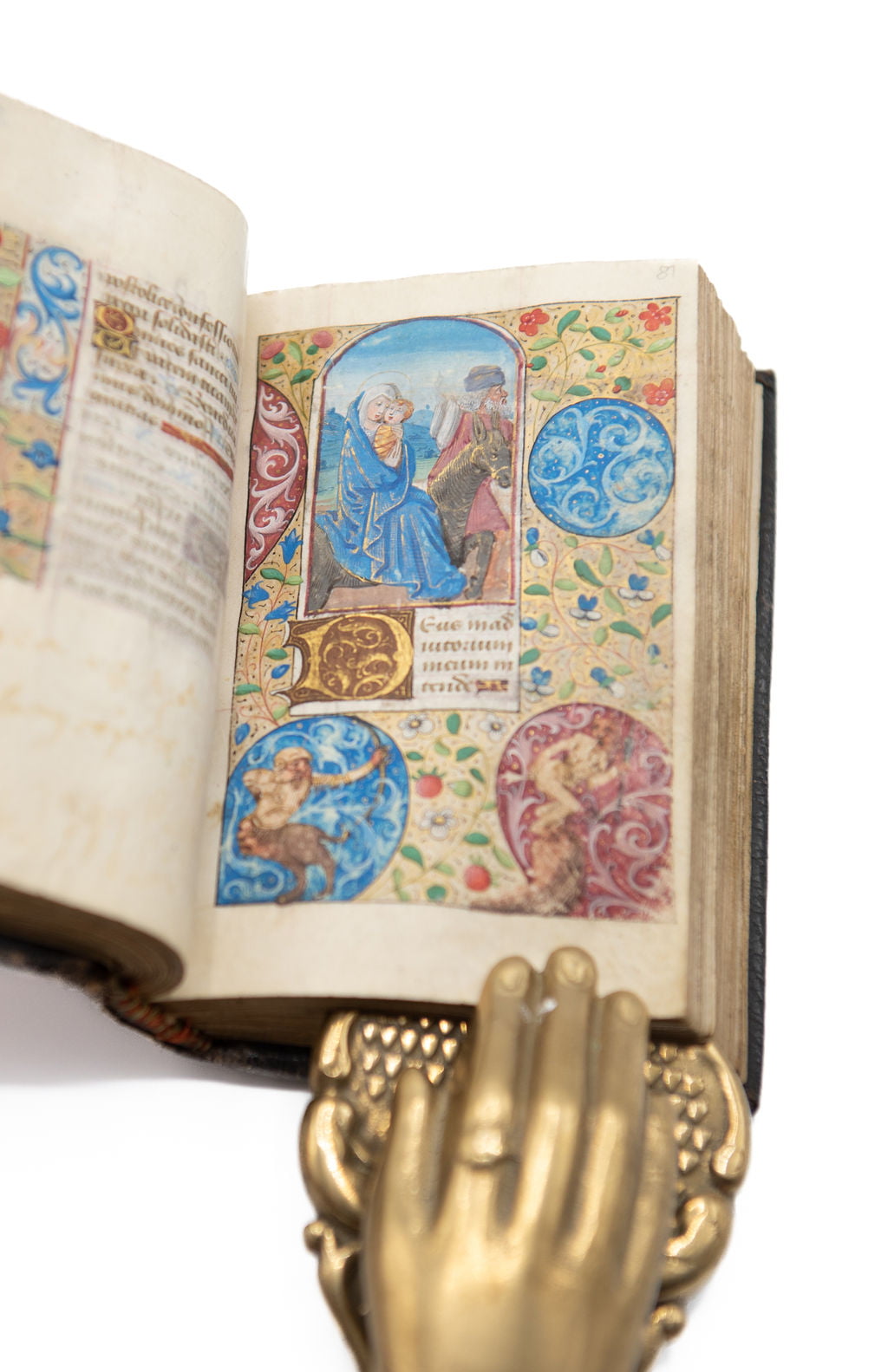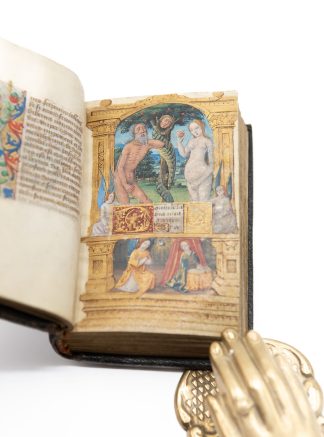BOOK OF HOURS
Near Miniature Book of Hours, Use of Rome, in Latin and French, illuminated manuscript on vellum
Northern France, (Paris), c. 1490-1510£85,000.00
209 leaves (plus 2 endleaves at front and back, ruled for main text, those at back loose in volume), wanting a few single leaves throughout (including two miniatures) and with some text leaves misbound at end, collation: i13 (first a cancelled blank, last blank), ii-viii8, ix7 (last leaf, once with miniature, cut away), x-xii8, xii4, xiv-xv8, xvi7 (last leaf, once with miniature, cut away), xvii-xxii8, xxiii2, xxiv-xxv8,, xvi6, xxvii2, xxviii6 (including pastedown) with a final blank bifolium tucked into the volume (gatherings xxvi onwards misbound and in part from elsewhere in same volume: see below), single column, 16 lines of a professional French lettre batârde with long ascenders and descenders stretching up and down from uppermost and lowermost line, rubrics in pale blue, initials in liquid gold on red and black grounds, line-fillers formed of tiny panels or woody stems in same, each text leaf with a decorative foliate panel, Calendar in red, blue and gold ink with decorative border panels enclosing roundels with miniatures of the occupations and zodiac symbols, six small square miniatures in Passion Readings and of Virgin and Christ, six three-quarter page miniatures set within wide decorated borders of liquid gold and coloured foliage enclosing snails, drollery animals and humans with animal legs (two of whom wear armour while one shoots an arrow into the other’s bottom), warring wildmen with clubs and bucklers, another hairy wildman who rides a polar bear, an angel, knights mounted on imaginary creatures, all on panels of brown, blue or dull-gold in various shapes, four three-quarter page miniature set within elaborate architectural frames, and enclosing another scene in their bas-de-page, slight cockling in places and a few leaves with tears to edges, some scuffing to paint in places with losses to edges of decorated borders, trimmed to edges of these borders, but overall in good and presentable condition, 115 by 78mm., bound in black morocco (circa 1600) tooled with outer frame of gilt dots on boards and floral rollstamps over thongs, separated from top three thongs at front.
The volume comprises: a Calendar (fol. 1r); Gospel Readings (fol. 14r); the Hours of the Virgin (fol. 22r); Seven Penitential Psalms (fol. 105r), followed by a Litany; the Hours of the Cross (wanting opening, fol. 128r); the Hours of the Holy Spirit (fol. 131v); the Office of the Dead (fol. 136r); the Suffrages to the Saints (fol. 178r), followed by prayers. To this has been added the prayer to St. Hubert (fol. 199r), followed by blanks (fols. 200-203, once the original end of the book). The volume now finishes with a single leaf with a prayer to the Virgin most probably from the original text block, and added prayers once among the additions at the end of the volume.
Illumination:
The miniatures here are the work of a notably close follower of the Master of the Chronique Scandeleuse, who flourished in Paris between 1490 and 1510, working for elite patrons there, and the quality and richness of the illumination suggests the direct influence of the master himself. Here are his distinctive ivory-skinned women, figures with half-closed eyes and ruby red lips, as well as his love for gilded architectural frames. The wealth of imagery in the border is impressive, with riotous wildmen fighting and being shot in the bottom with an arrow, men-at-arms with shaggy legs hunting, and perhaps strangest and rarest of all, a white bear on fol. 88v. While elephants, whales and similar are of staggering rarity in medieval manuscripts, no other example of a white bear is known to the present cataloguer.
In the medieval world white bears (whether polar bears or albino versions of mainland European breeds) were of astronomical rarity, and where they occur in our records it is always in connection with royal or near-royal status (King Cnut the Great was supposed in the late medieval Ramsey Abbey Chronicle to have given them twelve white bearskins to set before their altars; in 1252 Henry III of England received one as a gift from Norway; and in the fifteenth century Louis de Gruuthuse presided over tournaments named the ‘White Bear jousts’, but these were confined to wealthy burghers of Bruges). No white bear is recorded at any European court in the fifteenth century, but it is possible that the artist had seen a polar bear skin or that the original owner owned one (if so it would be an equal treasure to this opulent volume). Alternatively the bear may have been included here as an example of the strange and fantastical world beyond the boundaries of mainland Europe, which gripped the mind of medieval man.
The large miniatures comprise: 1. fol. 22r, Adam and Eve standing beside the Tree of Knowledge as the serpent (a green bulbous snake with a human head) looks down at Eve as she bites the apple, Adam raising his hand to his throat in horror, another scene of the Annunciation to the Virgin, two angels supporting the text frame, all set within ornate architectural borders; 2. fol. 47r, the Visitation of the Virgin to St. Anne, the borders with a snail and a dragon with a face in its chest; 3. fol. 62r, the Nativity, with Mary, Joseph and a female attendant adoring the Child inside a dark interior, two wildmen with clubs and bucklers in the margin; 4. fol. 67v, the Annunciation to the Shepherds, with a kneeling angel looking on from the border as two armed men fight below (one spearing the other from the back of a long-necked quadruped animal; 5. fol. 72v, the Adoration of the Magi, with wildmen with clubs and shields carved with human faces in lower border; 6. fol. 81r, Flight into Egypt, with a man-at-arms with shaggy legs firing an arrow from a longbow at the moment the arrow lodges in the bottom of a wildmen whose faces contorts in surprise; 7. fol. 88v, the Coronation of the Virgin, with the Virgin seated beside God the Father as he crowns her, a tiny wildman riding a white bear flecked with liquid gold penstrokes in the margin next to them, above another man-at-arms who fires a blow? at a surprised wildman; 8. fol. 105r, King David enthroned and surrounded by female attendants, above another scene of him receiving his vision in the wilderness, two angels supporting the text frame and a golden archer picked out in the initial, all within finely painted architectural frame; 9. fol. 131v, Pentecost, above another scene of the Pascal sacrifice, the lamb burning on a hillock before a crowd of followers and a Benedictine monk with his hands clasped in prayer, text frame supported by two knights in armour, all within architectural frame; 10. Fol. 136r, Judgement Day, with Christ in blessing in the upper compartment and the dead rising from their graves in the lower, two wildmen supporting the text frame, all within architectural frame.
Provenance:The patron who commissioned this volume may be the tonsured Benedictine monk who appears praying next to the secondary miniature of the Paschal sacrifice at the foot of fol. 131v. If so, then his personal devotion to this event may well explain its uncommon inclusion in the imagery. Where in France he lived is harder to pin down. St. Denis is in gold in the Calendar (9 October), as is Geneviève for the day of the procession of her relics on 26 November, but the absence of her main feast day in January suggests that he was not Parisian.Some saints point in general to the Franche-Comte (such as Medard and Boniface), but there are also minor local saints almost from the four corners of France: SS. Albin of Angers (1 March), Ferreol of Besançon (patron of the town, 16 June); and Ferreol of Limoges (18 September). Early in its life the book appears to have been used on the French-Flemish border, as a near-contemporary hand added a French verse prayer to St. Hubert (bishop of Liège in the eighth century) at its original end (now fol. 199r).In stock


